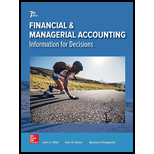
Net present value method is a measure to compare the current worth of cash inflows and current worth of cash outflows to determine the profitability of an investment decision.
Payback Period:
Payback period refers to the time period needed to recover the amount invested in project from the
Formula to calculate payback period,
Cash flow is as statement of sum total of income received also referred as cash inflows and expense incurred referred as
To compute: Payback period and net present value (NPV) of the investment.
Explanation of Solution
Payback Period
Given below is the table for the computation of payback period:
| Year | Net cash flows ($) | Cumulative net cash flows ($) |
| 0 | | |
| 1 | 1,000 | |
| 2 | 2,000 | |
| 3 | 3,000 | |
| 4 | 6,000 | |
| 5 | 7,000 | 4,000 |
Formula to calculate total payback period,
Substitute $3,000 for negative cumulative cash flows of 4th year and $7,000 for net cash flow of the 5th year.
Hence, payback period of investment of $15,000 is 4.4 years.
Net Present Value (NPV)
Given below is the table for the computation of Net Present Value (NPV).
| Year | Cash flows ($) | Present value of 1 at 10% | Present value of net cash flows ($) |
| 1 | 1,000 | 0.9091 | 9,09.10 |
| 2 | 2,000 | 0.8264 | 1,652.80 |
| 3 | 3,000 | 0.7513 | 2,253.90 |
| 4 | 6,000 | 0.6209 | 4,098.00 |
| 5 | 7,000 | 4,346.30 | |
| Total cash flows | 13,260.10 | ||
| Invested amount | 15,000 | | |
| Net present value | | ||
Hence, NPV for investment is $(1,739.90) as the total flows did not recover the invested amount of $15,000.
Payback Period
Given below is the table for the computation of payback period according to the website detail:
| Year | Net cash flows ($) | Cumulative net cash flows ($) |
| 0 | | |
| 1 | 7,000 | |
| 2 | 6,000 | |
| 3 | 3,000 | 1,000 |
| 4 | 2,000 | 3,000 |
| 5 | 1,000 | 4,000 |
- As per above table, the cash flow is positive after 2nd year, hence it can be said that cash flow is received after 2nd year.
- In order to find the actual payback period, divide the negative cumulative net cash flows of 2nd year by the net cash flow of the 3rd year, then add the given duration to the 2nd year.
Formula to calculate total payback period,
Substitute $2,000 for negative cumulative cash flows of 2nd year and $7,000 for net cash flow of the 3rd year.
Hence, payback period of investment of $15,000 is 2.66 years.
Net Present Value (NPV)
Given below is the table for the computation of Net Present Value (NPV).
| Year | Cash flows ($) | Present value of 1 at 10% | Present value of net cash flows ($) |
| 1 | 7,000 | 0.9091 | 6,363.70 |
| 2 | 6,000 | 0.8264 | 4,958.40 |
| 3 | 3,000 | 0.7513 | 2,253.90 |
| 4 | 2,000 | 0.6830 | 1,366.00 |
| 5 | 1,000 | 0.6209 | 620.90 |
| Total cash flows | 15,562.90 | ||
| Invested amount | 15,000 | | |
| Net present value | | ||
Hence, NPV for investment is $562.90.
Hence, the project as per book sum has higher payback period and negative NPV as compared to website sum. This will result in rejection of the project.
Want to see more full solutions like this?
Chapter 24 Solutions
Loose-Leaf for Financial and Managerial Accounting
- Please provide the accurate answer to this financial accounting problem using appropriate methods.arrow_forwardPlease help me solve this general accounting question using the right accounting principles.arrow_forwardAccounts Payable A chain of appliance stores, APP Corporation, purchases inventory with a net price of $400,000 each day. The company purchases the inventory under the credit terms of 1/15, net 35. APP always takes the discount but takes the full 15 days to pay its bills. What is the average accounts payable for APP?arrow_forward
- Please explain the solution to this financial accounting problem with accurate principles.arrow_forwardCan you help me solve this general accounting question using valid accounting techniques?arrow_forwardI am trying to find the accurate solution to this general accounting problem with the correct explanation.arrow_forward
- Please provide the correct answer to this general accounting problem using accurate calculations.arrow_forwardPlease explain the solution to this general accounting problem using the correct accounting principles.arrow_forwardCost of Trade Credit A large retailer obtains merchandise under the credit terms of 3/20, net 35, but routinely takes 65 days to pay its bills. (Because the retailer is an important customer, suppliers allow the firm to stretch its credit terms.) What is the retailer's effective cost of trade credit? Assume a 365-day year. Do not round intermediate calculations. Round your answer to two decimal places. 25.10 is incorrect.arrow_forward
- Can you explain the correct approach to solve this general accounting question?arrow_forwardPlease provide the correct answer to this general accounting problem using valid calculations.arrow_forwardPlease provide the accurate answer to this general accounting problem using appropriate methods.arrow_forward

 AccountingAccountingISBN:9781337272094Author:WARREN, Carl S., Reeve, James M., Duchac, Jonathan E.Publisher:Cengage Learning,
AccountingAccountingISBN:9781337272094Author:WARREN, Carl S., Reeve, James M., Duchac, Jonathan E.Publisher:Cengage Learning, Accounting Information SystemsAccountingISBN:9781337619202Author:Hall, James A.Publisher:Cengage Learning,
Accounting Information SystemsAccountingISBN:9781337619202Author:Hall, James A.Publisher:Cengage Learning, Horngren's Cost Accounting: A Managerial Emphasis...AccountingISBN:9780134475585Author:Srikant M. Datar, Madhav V. RajanPublisher:PEARSON
Horngren's Cost Accounting: A Managerial Emphasis...AccountingISBN:9780134475585Author:Srikant M. Datar, Madhav V. RajanPublisher:PEARSON Intermediate AccountingAccountingISBN:9781259722660Author:J. David Spiceland, Mark W. Nelson, Wayne M ThomasPublisher:McGraw-Hill Education
Intermediate AccountingAccountingISBN:9781259722660Author:J. David Spiceland, Mark W. Nelson, Wayne M ThomasPublisher:McGraw-Hill Education Financial and Managerial AccountingAccountingISBN:9781259726705Author:John J Wild, Ken W. Shaw, Barbara Chiappetta Fundamental Accounting PrinciplesPublisher:McGraw-Hill Education
Financial and Managerial AccountingAccountingISBN:9781259726705Author:John J Wild, Ken W. Shaw, Barbara Chiappetta Fundamental Accounting PrinciplesPublisher:McGraw-Hill Education





